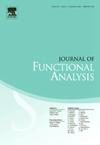Reducibility for the linearized two-component intermediate long-wave equation
IF 1.7
2区 数学
Q1 MATHEMATICS
引用次数: 0
Abstract
In this paper, we study the reducibility of a class of linear operators depending on time quasi-periodically, which arises from linearizing the two-component intermediate long-wave equation at a small amplitude quasi-periodic function, with a Diophantine frequency vector . We prove that there exists a Cantor-like set such that for every , these operators can be reduced to the ones with constant coefficients by some linear, real, reversibility-preserving and quasi-periodic time-dependent transformations. As a conclusion, the stability of the solutions of the linearized two-component intermediate long-wave equation is obtained. Besides the KAM reducibility transformation, these transformations are obtained from some pseudo-differential operators and the flows of some PDEs. The key difficulty lies in estimating the norms and the upper and lower bounds of the operators related to the integral operator due to their complicated structures. To overcome the difficulties, we treat these operators as the principal pseudo-differential operators up to the remainders of lower order and impose some constraints on the parameters.
求助全文
约1分钟内获得全文
求助全文
来源期刊
CiteScore
3.20
自引率
5.90%
发文量
271
审稿时长
7.5 months
期刊介绍:
The Journal of Functional Analysis presents original research papers in all scientific disciplines in which modern functional analysis plays a basic role. Articles by scientists in a variety of interdisciplinary areas are published.
Research Areas Include:
• Significant applications of functional analysis, including those to other areas of mathematics
• New developments in functional analysis
• Contributions to important problems in and challenges to functional analysis

 求助内容:
求助内容: 应助结果提醒方式:
应助结果提醒方式:


